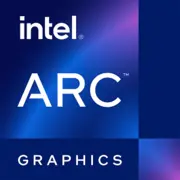Intel Arc A310

Intel Arc A310: Budget GPU for Everyday Tasks and Gaming
Overview of the 2025 graphics card for those seeking a balance between price and capabilities
1. Architecture and Key Features
Xe-HPG Architecture: The Evolution of Intel
The Intel Arc A310 graphics card is built on the Xe-HPG architecture (Xe High Performance Graphics), which debuted in 2022. By 2025, Intel has optimized its solutions, emphasizing energy efficiency and support for modern technologies. The A310 utilizes a 6nm manufacturing process from TSMC, which has helped reduce heat generation and improve transistor density compared to earlier models in the Arc series.
Unique Features
- XeSS (Xe Super Sampling): This is Intel's answer to NVIDIA's DLSS and AMD's FSR. The technology increases FPS in games through AI-driven image scaling. The A310 uses a simplified version of XeSS, showing performance boosts of up to 30% at 1080p.
- Hardware Ray Tracing: RT Core blocks provide RTX support, but due to a limited number of cores, performance in ray tracing modes is modest (more details in section 3).
- FidelityFX Support: Compatibility with AMD technologies including CAS (Contrast Adaptive Sharpening), which expands the list of optimized games.
2. Memory: Speed and Capacity
GDDR6 and 96-Bit Bus
The Arc A310 is equipped with 4 GB of GDDR6 memory and a 96-bit bus. The bandwidth reaches 192 GB/s, which is sufficient for most tasks at 1080p resolution, but in high-load scenarios (such as 4K textures), slowdowns may occur.
Impact on Performance
The limited memory capacity (4 GB) makes the card less appealing for modern AAA games at ultra-settings. However, in eSports titles (CS2, Valorant) or at medium graphical presets, memory does not become a bottleneck. For video editing in 1080p, resources are adequate, but working with 4K footage will require project optimization.
3. Gaming Performance
1080p: Comfortable Gaming
- Cyberpunk 2077 (No RT): Average FPS — 45-50 (medium settings, XeSS enabled).
- Fortnite (Epic Settings): 60-70 FPS.
- Hogwarts Legacy: 40-45 FPS (medium settings).
1440p and 4K: Only for Undemanding Titles
At 1440p resolution, FPS drops by 25-40%. For instance, in Apex Legends, the average is around 50 FPS. 4K gaming is possible only in older games (Skyrim, GTA V) or at minimal settings.
Ray Tracing: Not for Weak PCs
Enabling RT reduces FPS by 50-60%. In Cyberpunk 2077 with Medium RT settings, the card only achieves 20-25 FPS. Using XeSS in balanced mode is recommended to compensate for performance losses.
4. Professional Tasks
Video Editing and Rendering
The A310 supports hardware AV1 encoding/decoding, which speeds up work in DaVinci Resolve and Adobe Premiere. Rendering a 10-minute video at 1080p takes about 15 minutes (compared to 22 minutes on the NVIDIA GTX 1650).
3D Modeling
In Blender and Maya, the card demonstrates modest results due to a limited number of compute cores. It is suitable for simple scenes, but complex projects are better rendered on a GPU with CUDA support (NVIDIA) or with more VRAM.
Scientific Calculations
With OpenCL and DP4a support, the A310 can be used for entry-level machine learning tasks; however, its performance is 2-3 times lower than that of the NVIDIA RTX 3050.
5. Power Consumption and Cooling
TDP 75W: Powered via PCIe Slot
The card does not require additional power cables, simplifying the assembly of compact PCs. With a TDP of 75W, it is one of the most energy-efficient in its class.
Cooling Recommendations
The A310 is available in two versions: with passive (fanless) and active cooling. For cases with poor ventilation, the model with a cooler is preferable. The ideal case is a Mini-ITX with 1-2 exhaust fans.
6. Comparison with Competitors
NVIDIA GeForce GTX 1650
- Pros of NVIDIA: Better driver optimization, support for DLSS.
- Cons: No AV1 decoder, more expensive ($140 vs. $120 for the A310).
AMD Radeon RX 6400
- Pros of AMD: Slightly higher FPS in Vulkan games.
- Cons: Lack of hardware RT, driver issues on Linux.
Conclusion: The A310 wins with support for AV1 and XeSS but loses in raw performance.
7. Practical Tips
Power Supply: A 400W unit is sufficient (e.g., be quiet! System Power 10).
Compatibility:
- Motherboards with PCIe 4.0 x8 (backward compatible with PCIe 3.0).
- Be sure to update drivers to version 2025.4 or newer — this will improve stability in DX12 games.
Driver Nuances:
- Support on Linux is currently weaker than for AMD and NVIDIA.
- For streaming, use OBS with AV1 enabled — this will reduce CPU load.
8. Pros and Cons
Pros:
- Low price ($120-130).
- Support for AV1 and XeSS.
- Energy efficiency.
Cons:
- Only 4 GB of memory.
- Limited performance in RT scenarios.
- Drivers still require refinement.
9. Final Verdict: Who Is the Arc A310 For?
This graphics card is an ideal choice for:
- Budget gamers playing at 1080p on medium settings.
- Office PCs with occasional gaming (such as Fortnite or CS2).
- HTPC systems, where AV1 decoding is important for 4K streaming.
- Users who need modern architecture at minimal cost.
If you are not ready to spend more than $150 and are looking for a card for everyday tasks, the A310 will be a reasonable compromise. However, for professional 3D rendering or 4K gaming, it’s best to consider more powerful options.
Prices are current as of April 2025. Information is based on manufacturer data and independent testing.
Basic
Memory Specifications
Theoretical Performance
Miscellaneous
Benchmarks
Compared to Other GPU
Share in social media
Or Link To Us
<a href="https://cputronic.com/en/gpu/intel-arc-a310" target="_blank">Intel Arc A310</a>